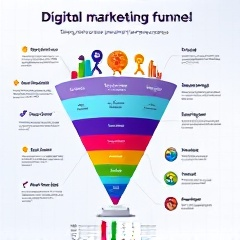Review of the book "Mobile Application Marketing" - Margarita Akulich. A practical guide to mobile application marketing
The book scrutinizes not only user acquisition strategies but also meticulously analyzes miscalculations:
- Unsuccessful A/B testing, leading to a decrease in retention
The author examines with particular care, allowing not just to absorb information but also to feel it on one's own mistakes. While reading, you catch yourself thinking: this book is not dry theory, but a collection of combat instructions, where each section pulsates with live case studies, and recommendations on ASO and competitor analysis make you look at your project from a new angle.
Akulich seems to lead by the hand through the turbulent waters of the market, not letting you slip on the banana peel of underestimating the target audience, and all this is served in such a tone that even a tired marketer cannot remain indifferent - you want to run and implement right away.
Key Concepts and Their Analysis

Instead of trudging along well-worn paths, the author bluntly throws the reader into the heart of marketing battles: here, not abstract schemes are analyzed, but specific tactics that actually work (or fail spectacularly).
- Analysis of retention mechanisms: the pages are filled with numbers that clearly demonstrate how a seemingly minor adjustment to the welcome chain leads to a surge in returns.
- Analysis of failures: the author is not afraid to discuss the reasons for the decline in coverage after an unsuccessful creative change, offering a critical view of each hypothesis.
- Scrupulous approach to competitor analysis: here, you won't find vague advice, but rather a detailed checklist of steps.
With each page, it becomes increasingly clear: the book doesn't pull the blanket over itself, but invites an open analysis of real tools that not only embellish the report but help get the most out of the product in practice.
Who is the book for
However, you shouldn't think that this is reading for a closed club of "initiates": on the contrary, the pages are addressed to those who daily rack their brains with questions about how to pull their project out of the swamp of invisibility in app stores and make users not just download, but stay.
- Novices who have just stepped onto the shaky ground of digital promotion.
- Seasoned players who have had their fair share of failures and successes.
Novices get: a step-by-step plan where every action is detailed down to the smallest nuance - from the first test launches to fine-tuning analytics.
Experienced practitioners can: try on fresh perspectives on established processes and catch non-standard solutions to the age-old problem of retention.
What's especially valuable: the author doesn't stop at theory - every piece of advice is immediately backed up by a concrete case, where real numbers, budgets, and metrics replace abstractions.
This book: is not for armchair strategists, but for those who are used to working on the front lines and are ready to dive into the details in the fight for:
- every installation,
- every percentage of conversion,
- every mistake that can turn into an important lesson.
About the author and their significance in marketing

Contrary to the common notion of "theorists on three chairs", behind this guide is a person for whom the marketing kitchen has long ceased to be a laboratory - Margarita Akulich hasn't just seen numbers, she has made them herself, managing campaigns with budgets in which a novice can easily drown.
- Professional track record: behind her are not abstract "successful cases", but concrete launches.
Every piece of advice she gives: doesn't seem to be pulled out of thin air or copied from Western blogs - you can feel that these recommendations are backed by doubts, mistakes, and, most importantly, uncompromising honesty towards herself and the reader.
This combination of practice and self-irony: is a rare beast in professional literature, where either academic dullness or self-satisfied posing usually reigns.
The place of the book in modern marketing literature
Against the backdrop of pseudoscientific brochures and meaningless manuals, where Google articles from five years ago are rehashed and passed off as insights, this work stands out like a rare find in a dull stream of self-repetition.
There is no room for banal advice like "run ads on social media" or sluggish reasoning about trends — each chapter, supported by numbers and real market failures, surgically exposes the pain points of the digital age.
If in other publications the reader sinks in abstractions, here you will find clearly verified tools that you can implement tomorrow, whether in a startup or a corporation with a turnover of over a billion.
It's no surprise that this book instantly became part of the arsenal of specialists for whom failure is not just a theoretical mistake, but a tangible minus in the quarterly report.
Against the general background of literature on the topic, where authors often skillfully maneuver between common recommendations, this guide bursts in like a breath of icy air:
- without embellishment
- without water
- with maximum practical impact
| Criterion | Book | Other publications |
|---|---|---|
| Practical usefulness | High | Low |
| Relevance of information | Relevant | Outdated |
| Style of presentation | Clear and structured | Vague |
Relevance of the publication at the current moment

In an era when the popularity curve of mobile services is reaching its peak, and the cost of attracting a user sometimes catches up with space values, the freshness of solutions becomes a matter of survival, not just improving efficiency. That is why this book hits the nail on the head of today's realities:
- It doesn't waste time on banal wishes like "try new channels";
- It analyzes why the retention of new users drops to 25% after the first week;
- It discusses what to do when you don't have an army of developers behind you, and your budget is at the level of an average salary in the market.
The author doesn't indulge in dreams of "viral magic", but instead arms the reader with methodologies that can be implemented under tight deadlines and limited resources:
- Proper audience segmentation;
- Implementation of A/B testing at early stages.
The relevance of the publication is obvious: the number of app downloads is growing, competition is becoming fierce, and the only chance not to get lost in this digital ocean is to act according to a plan that actually works here and now.
Fundamental Marketing Concepts

If you strip away the fluff of pseudo-innovations, then at the very heart of the book, the basic pillars emerge that not only support digital marketing but also the logic of building a successful funnel:
- The customer lifecycle with its cynically short first session
- Anatomy of LTV
- Balance between the cost of acquisition and real return on investment
Unlike endless "how-to" guides, the author deliberately exposes the underlying mechanics:
- Competent segmentation is a necessary tool
- Ignoring cohort analysis is a dangerous strategy
A detailed analysis of retention strategies and a clear explanation of what a "quality user" means in 2025, forces you to look at familiar terms as a set of tools that determine the survival of your product in a ruthlessly competitive environment.
The honesty of the narrative is captivating: no hidden pitfalls, such as false savings on analytics or attempts to "boost" metrics through dubious channels - everything is laid out on the shelves, with numbers and examples, creating a tangible chill down the spine for those who hope to "get lucky".
Innovative ideas and modern trends
Diving into the layer of the latest trends, the author is not limited to banal reasoning about “virality” and “native”, but clearly reveals how the playing field is changing under the onslaught of algorithms, personalized communication, and “smart” triggers.
- Hypersegmentation: becomes a real revelation.
- Concrete schemes: slicing the audience into thin layers.
- Push notifications: conversion growth reaches high percentages with targeted delivery.
It is especially valuable that there is no place for dry theory here: the focus is on automated scenarios, A/B testing in real campaigns, and fresh analytics tools that have just appeared on the market — all this not only demonstrates knowledge of the “latest thing”, but also provides working leverage for those who want to keep up with the times, rather than gathering dust on the sidelines of progress.
Sometimes it even becomes embarrassing for colleagues who continue to worship outdated methods: it is clear here that if you're not willing to change, the market won't spare you.
Applicability of Concepts in Modern Business
Without unnecessary ceremony, the author confidently brings to the forefront not just trendy terms, but real, applicable steps that are already changing the rules of the game for those who are not new to business.
- Working with the target audience: instead of abstract portraits — clear methodologies that allow you to "feel out" the user's pain points down to the nuances of their evening habits.
- Growth of engagement: this translates into a tangible increase in engagement.
- Automated interaction scenarios: the implementation algorithm is described in detail — not just for the sake of it, but for a real increase in retention.
- Testing hypotheses: the author makes you break down processes into components, test each hypothesis in practice.
- Abandoning ineffective methods: don't be afraid to throw overboard everything that doesn't work.
Reading these chapters, it's impossible to shake off the feeling that you're being literally pushed to take action: take and implement, or you'll be left on the sidelines of the market.
| Methodology | Effectiveness |
|---|---|
| Working with the target audience | |
| Automated scenarios | |
| Testing hypotheses | |
| Abandoning ineffective methods |
Cases and examples from real business
The author's practical vein is especially evident in the section where specific business cases are analyzed: here you won't find sterile success stories from glossy presentations - on the contrary, the pages of the book come alive with genuine implementation episodes, where numbers and user feedback become the ultimate judge.
- Example: analysis of the implementation of push strategies with a subsequent increase in the active base
- Analysis: unsuccessful attempt at gamification, which led to a massive outflow of audience
All of this is presented with surgical precision and honesty, inspiring respect. The author is not afraid to talk about failures, emphasizing that mistakes are not a reason to panic, but a starting point for finding new solutions.
As a result, after reading, you feel like you've been to a closed analysis of the most relevant industry cases, where there's no room for embellishment - only facts, numbers, and working conclusions. It's this approach that gives you a chance not just to gain experience, but to actually grow professionally, avoiding the pitfalls others have already encountered.
Strengths of the publication
Having barely turned over a dozen pages, you catch yourself thinking: here it is — a rare combination of specificity and deep immersion in the reality of the digital market, which doesn't slide into preachy mantras or banal checklists.
Here, each chapter is like a practical laboratory, where instead of boring definitions, the reader gets a toolkit tested on real mistakes and victories, not abstract schemes.
It's especially valuable that the author doesn't get lost in lofty theories, but offers working solutions that can be implemented literally “here and now”, without waiting for ideal conditions or a million-dollar budget.
- Segmentation strategies
- Methods for increasing retention
- Multi-layered analysis of acquisition channels
All this is not just listed, but dissected into tiny parts, as if the author had conducted a thorough review of every line of code within successful applications.
You read and feel: there's no room for naive illusions here, just a honest conversation about how not to drown in a sea of competitors and squeeze the maximum out of even modest resources.
This is exactly where the book's strongest aspect lies — it becomes a desktop tool for those who are tired of "water" and are ready to get results.
Critical Analysis
However, not everything is smooth sailing in the Danish kingdom - just when you think you're holding a encyclopedia of practical solutions, you stumble upon gaps:
- in some places, the author glosses over the real difficulties, as if hoping that the reader will figure out how to get out of a tricky situation on their own.
- the breakdown into stages of working with the audience and analytics of attraction channels is done with precision,
- but sometimes what's missing is the "kitchen" where the real cooking happens - discussions of failures, setbacks, and debatable decisions.
- Descriptions of optimization in stores, no matter how you spin it, reek of an overly academic spirit: the recommendations are too cautious.
- As a result, there's a feeling that hardcore and real numbers are lacking in places, which would allow one to look at processes without rose-colored glasses.
On the other hand, even such a measured presentation of information can provoke a curious marketer to have a desire to dig deeper - and perhaps it's this very understatement that prompts action, rather than simply passively devouring ready-made solutions.
Tools and techniques for practical use
As for the set of tools and techniques, the author provides a whole arsenal:
- Analysis of the structure of advertising campaigns in Digital
- Step-by-step scheme for working with user reviews
- KPI tables
- Checklists for launch
But, alas, in some places the practical value seems to dissolve in the air: the advice is too generalized, it seems to be copied from presentations for students, rather than being developed in real combat conditions.
For example, recommendations for testing hypotheses are more like a memo “for dummies”, rather than a working cheat sheet for those who are up to their ears in daily analytics. There's a lack of sharpness — some non-standard moves, fresh frameworks, or at least a couple of frank admissions about how A/B tests are actually launched with a budget of 50 thousand rubles and what happens when the numbers go awry.
However, for beginning specialists, this set will still be useful:
- Structured presentation
- Step-by-step instructions
But those who want to fight for every percent of conversion and are used to counting money at every stage will want more — specifics, live data, not just neatly laid out advice.
| Criteria | Beginning specialists | Experienced specialists |
|---|---|---|
| Usefulness | High | Average |
| Usability | Structured instructions | Lack of specifics |
| Applicability | Suitable | Lack of sharpness |
Popularity of the real publication

Surprisingly, despite the abundance of training materials and a pile of free webinars, it was this book that managed to climb to the top lines of specialized ratings, and, judging by the numbers, is not going to give up its positions.
In reviews, people fiercely argue:
- Some scold for the lack of "kitchen".
- Others, on the contrary, praise for systematicity and restraint without unnecessary emotions.
However, the popularity of the publication is explainable: for beginners, it is a rare opportunity to get a structured guide on a rapidly changing industry, where, as is known, yesterday's life hack is no longer needed today.
Practitioners, however, read with a critical squint:
- They lack depth, fresh insights and real failures, without which there is no real growth.
But it cannot be denied that against the background of empty promises and retellings of Western blogs, this work looks at least honestly compiled and does not try to sell golden mountains.
Other works by the author
However, to truly appreciate the scale of the author's professionalism, it is impossible to limit oneself to just one sensational publication - Margarita Akulich has already had more than one work behind her, each of which is like a brick in the methodical construction of the national school of digital promotion.
- Example: her previous work on mobile traffic analytics, although it did not gather such a wave of discussion on specialized forums, is still cited in articles on vc.ru and is found in the lists of required reading on courses for junior marketers.
- Fresh book: takes the novice by the hand and leads him through the jungle of terminology and numbers.
- Earlier publications: immerse the reader in the routine of analyzing user scenarios and analyzing errors when launching advertising campaigns - without embellishment, with dry tables and real metrics from projects.
- Evolution of works: from stingy checklists and thematic cheat sheets to full-fledged conceptual strategies, where there is no longer room for banal life hacks for likes.
- The author's path: from a pragmatic craftsman to an expert who sets the tone in the professional community - commands respect even from those who prefer "dirty insights" to dry analytics.
Comparison with Other Works by the Author
Delving into Margarita's bibliography, it's not hard to discern a pattern: each new publication is like a step up a steep staircase, where earlier book attempts were more like workbooks, and the current one is a detailed map of the terrain with marked traps and shortcuts to the goal.
- The author's early works, despite their conciseness and almost ascetic simplicity, were distinguished by their "down-to-earth" utility:
- User scenario analyses, broken down into components
- Honest mistakes that are inevitable in any advertising campaign
Against this backdrop, the current book appears as a quantum leap: instead of dry checklists, there's a breakdown of strategies into atoms for attracting and retaining an audience, and instead of hasty advice, there's a systematic view of the conversion funnel, where every figure is backed by a specific case, rather than a retelling of others' successes.
In comparison with her previous publications, here one particularly feels the confidence of a mature practitioner, who is ready not just to give out fishing rods but also to teach how to distinguish valuable fish from futile fuss with the net.
This is not just a set of tools — it's a clearly structured methodology, and observing this progress is far more interesting than watching another compilation of "100 ways to boost installs."
| Element | Previously | Now |
|---|---|---|
| User Scenarios | Broken down into components | Atomic breakdown of strategies |
| Advice | Hasty | Systematic approach |
| Methodology | Set of tools | Clearly structured methodology |
Similar literature by other authors
If you try to put this edition on the same shelf as bestsellers, like the work of Andrew Chen or guides from Eric Siegel, a striking difference immediately catches the eye:
- Western gurus throw around English terms and sometimes get bogged down in consulting generalizations.
- The domestic author speaks the same language as the reader and doesn't slip into self-evident banalities.
For example, in Chen's work:
- “Cold Start Problem” turns into an almost sacred mantra, but there are very few practical tips.
In Akulich's work, every concept is backed by a real case from Russian reality, and everything is broken down to such an extent that even a novice doesn't need to Google the decoding of terms.
If we compare it with domestic authors, then against the background of Petr Ponomarev's works, Margarita's book looks like a breath of fresh air:
- Slow-paced retellings of others' strategies.
- Criticism, live experience, analysis of not only successes but also failures with specific numbers.
If you have to choose between another compilation of English trends and this detailed analysis of market realities, the choice is obvious — and not in favor of another carbon-copy “life hack”.
